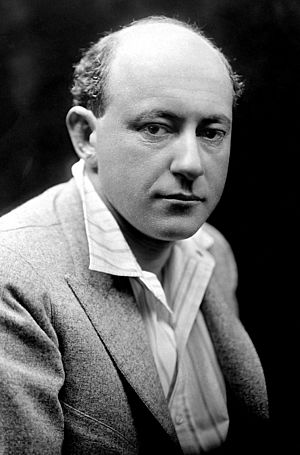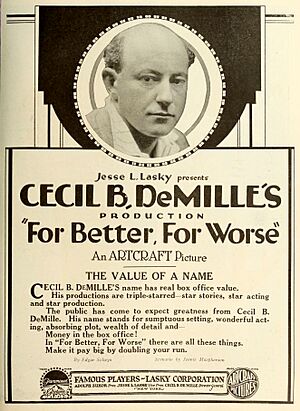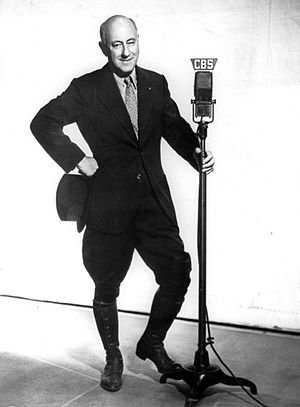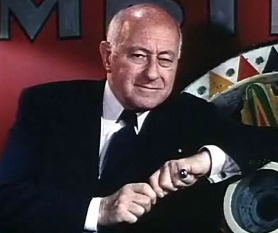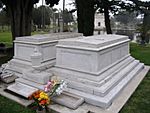Cecil B. DeMille facts for kids
Cecil Blount DeMille (born August 12, 1881 – died January 21, 1959) was a famous American filmmaker. He made 70 movies between 1913 and 1956. These included both silent films (without sound) and sound films (with sound). Many people see him as a founder of Hollywood cinema. He was one of the most successful producer-directors in movie history.
DeMille's movies were known for being very grand and epic. He was also a master at creating exciting shows on screen. He made silent films of many types. These included dramas, comedies, Westerns, and historical stories.
DeMille started his career as an actor in 1900. Later, he began writing and directing plays. He sometimes worked with Jesse Lasky, who produced stage shows. DeMille's first movie, The Squaw Man (1914), was important. It was the first full-length movie ever filmed in Hollywood. This movie was a huge hit and helped put Hollywood on the map.
Because his movies were so successful, he helped start Paramount Pictures. He founded it with Jesse Lasky and Adolph Zukor. His first big Bible story movie was The Ten Commandments (1923). It was a success with both critics and audiences. It held the record for the most money earned by a Paramount film for 25 years!
In 1927, he directed The King of Kings. This movie was about Jesus. It was praised for being very thoughtful and was seen by over 800 million people. The Sign of the Cross (1932) was special. It was the first sound film to use all parts of filmmaking together. Cleopatra (1934) was his first movie nominated for the Academy Award for Best Picture.
After more than 30 years, DeMille reached the top of his career. This was with Samson and Delilah (1949). This Bible epic made a record amount of money. Besides Bible and history stories, he also made films about people fighting against nature.
He was nominated for the Academy Award for Best Director for his circus movie, The Greatest Show on Earth (1952). This film also won the Academy Award for Best Picture. His last and most famous movie was The Ten Commandments (1956). It is still one of the highest-earning films of all time when you adjust for inflation.
DeMille received many awards. He got an Academy Honorary Award for his work in film. He also won the Palme d'Or (after he passed away) for Union Pacific. He received a DGA Award for his whole career. He also won the Irving G. Thalberg Memorial Award. He was the first person to receive the Golden Globe Cecil B. DeMille Award, which was later named after him.
Contents
Career
Early Stage Work
DeMille started his career as an actor on Broadway in 1900. He worked for a theater company run by Charles Frohman. His brother, William, was a playwright. Sometimes, they worked together. DeMille acted with people he would later direct in movies. These included Mary Pickford.
DeMille also produced and directed plays. By 1913, he was finding it hard to support his family. Changes in theater meant his types of plays were no longer popular. True success on stage was hard to find.
Starting in Movies
In July 1913, DeMille, Jesse Lasky, and Sam Goldfish (who later became Samuel Goldwyn) started a movie company. It was called the Jesse L. Lasky Feature Play Company. On December 12, 1913, DeMille and his team traveled by train to Los Angeles. He had planned to film in Arizona, but he didn't like the light there.
Once in Los Angeles, he chose to film in Hollywood. At that time, most movies were only about 20 minutes long. DeMille decided to make his first movie 60 minutes long, like a short play. This movie, The Squaw Man (1914), was a huge hit. It helped make the Lasky Company famous.
The Silent Film Era
The first few years of the Lasky Company (which soon became Famous Players-Lasky) were very busy. They made movies non-stop and helped create the "language" of filmmaking. DeMille used special lighting techniques from theater in his films. He even made moonlight look real in The Warrens of Virginia.
After five years and 30 hit movies, DeMille became America's most successful director. In the silent film era, he was famous for movies like Male and Female (1919) and Manslaughter (1921). DeMille's movies often featured scenes with bathtubs or lion attacks. Some of his films even used early color technology called two-color Technicolor.
DeMille's silent films were so popular that he explored other businesses. He started Mercury Aviation Company, one of America's first airlines. He also bought and sold land. He even helped approve loans for other filmmakers at a bank.
The Sound Film Era
When "talking pictures" came out in 1928, DeMille successfully switched to making them. He even invented new tools to help. He created a microphone boom and a special soundproof cover for cameras. He also made the camera crane popular.
DeMille helped many unknown actors become stars. These included Gloria Swanson, Claudette Colbert, and Charlton Heston. He also worked with famous actors like Gary Cooper. DeMille was very loyal to his actors and often cast them in many movies.
DeMille was known for being very strict on set. He expected actors to be brave and take physical risks. He would even show them that a stunt was safe by doing it himself. For example, in Samson and Delilah, he wrestled a tame lion to show Victor Mature it was safe.
DeMille was very good at directing huge crowds of people. Many of his movies have amazing scenes with special effects. These include the pagan temple falling in Samson and Delilah. He also showed train wrecks in movies like Union Pacific and The Greatest Show on Earth. And, of course, the famous parting of the Red Sea in both versions of The Ten Commandments.
DeMille started using full three-strip Technicolor in North West Mounted Police (1940). Audiences loved the bright colors. After that, he only made color films.
His Showmanship
DeMille was one of the first directors to become a celebrity himself. He created an image of a powerful director. He often carried a megaphone and wore special riding pants. From 1936 to 1944, DeMille hosted Lux Radio Theater. This was a weekly radio show that presented popular movies as radio plays.
Other directors respected DeMille, even if they sometimes criticized his directing style. Director William Wellman once said DeMille's directing was "horrible." But he added, "He put on pictures that made a fortune. In that respect, he was better than any of us."
Producer David O. Selznick wrote that DeMille was "one of the most extraordinarily able showmen of modern times." He praised DeMille's amazing skill at making movies that everyone loved.
DeMille often appeared as himself in movies. He also introduced his own films in trailers and narrated many of his later movies. He even appeared on screen to introduce The Ten Commandments. He was famously shown in the movie Sunset Boulevard. In it, actress Gloria Swanson says the famous line: "All right, Mr. DeMille. I'm ready for my closeup." DeMille played himself in that film.
In the 1940s, DeMille continued to make popular movies. He usually made one film a year. Most of these were about historical figures or Bible stories. His movie The Greatest Show on Earth (1952) was about circus performers. This film earned him a nomination for best director and won an Oscar for best picture.
The Ten Commandments
In 1954, DeMille began his last film. This was The Ten Commandments, the movie he is most remembered for.
Legacy
Cecil B. DeMille received hundreds of awards and honors during his life.
Honors After His Death
DeMille has two stars on the Hollywood Walk of Fame. One is for his work in radio, and the other is for his movies.
Two schools were named after him: Cecil B. DeMille Middle School and Cecil B. DeMille Elementary School.
The former film building at Chapman University is named in his honor.
The Golden Globe's yearly Cecil B. DeMille Award recognizes people who have achieved a lot in the film industry. This award is named after him.
You can find many of Cecil B. DeMille's films and home videos at the Academy Film Archive.
Filmography
DeMille directed 70 movies. Sadly, seven of his early silent films were lost. These include The Arab and The Squaw Man (a remake). About 20 of his silent films are available to watch today.
Director
Silent films
- The Squaw Man (1914)
- Brewster's Millions (1914)
- The Master Mind (1914)
- The Only Son (1914)
- The Man on the Box (1914)
- The Call of the North (1914)
- The Virginian (1914)
- What's His Name (1914)
- The Man from Home (1914)
- Rose of the Rancho (1914)
- The Ghost Breaker (1914)
- The Girl of the Golden West (1915)
- After Five (1915)
- The Warrens of Virginia (1915)
- The Unafraid (1915)
- The Captive (1915)
- The Wild Goose Chase (1915)
- The Arab (1915)
- Chimmie Fadden (1915)
- Kindling (1915)
- Carmen (1915)
- Chimmie Fadden Out West (1915)
- The Cheat (1915)
- Temptation (1915)
- The Golden Chance (1915)
- The Trail of the Lonesome Pine (1916)
- The Heart of Nora Flynn (1916)
- Maria Rosa (1916)
- The Dream Girl (1916)
- Joan the Woman (1917)
- Lost and Won (1917)
- A Romance of the Redwoods (1917)
- The Little American (1917)
- The Woman God Forgot (1917)
- Nan of Music Mountain (1917)
- The Devil-Stone (1917)
- The Whispering Chorus (1918)
- Old Wives for New (1918)
- We Can't Have Everything (1918)
- Till I Come Back to You (1918)
- The Squaw Man (1918)
- Don't Change Your Husband (1919)
- For Better, for Worse (1919)
- Male and Female (1919)
- Why Change Your Wife? (1920)
- Something to Think About (1920)
- Forbidden Fruit (1921)
- The Affairs of Anatol (1921)
- Fool's Paradise (1921)
- Saturday Night (1922)
- Manslaughter (1922)
- Adam's Rib (1923)
- The Ten Commandments (1923)
- Triumph (1924)
- Feet of Clay (1924)
- The Golden Bed (1925)
- The Road to Yesterday (1925)
- The Volga Boatman (1926)
- The King of Kings (1927)
- Walking Back (1928)
- The Godless Girl (1929)
Sound films
- Dynamite (1929)
- Madam Satan (1930)
- The Squaw Man (1931)
- The Sign of the Cross (1932)
- This Day and Age (1933)
- Four Frightened People (1934)
- Cleopatra (1934)
- The Crusades (1935)
- The Plainsman (1936)
- The Buccaneer (1938)
- Union Pacific (1939)
- North West Mounted Police (1940)
- Reap the Wild Wind (1942)
- The Story of Dr. Wassell (1944)
- Unconquered (1947)
- California's Golden Beginning (1948, short subject)
- Samson and Delilah (1949)
- The Greatest Show on Earth (1952)
- The Ten Commandments (1956)
- The Buccaneer (1958, producer)
Actor
- The Squaw Man (1914) (cameo)
- A Trip to Paramountown (1922)
- Felix in Hollywood (1923)
- Hollywood (1923)
- Glamour Boy (1941)
- Star Spangled Rhythm (1942)
- Jens Mansson in America (1947)
- Variety Girl (1947)
- Sunset Boulevard (1950) (as himself)
- The Fallbrook Story (1951) (Narrator)
- Son of Paleface (1952) (cameo)
- The Greatest Show on Earth (1952, Narrator)
- The Ten Commandments (1956, Intro and narrator)
- The Buster Keaton Story (1957)
- The Buccaneer (1958) as Himself - Prologue (uncredited)
Personal Life and Death
DeMille married Constance Adams on August 16, 1902. They had one child, Cecilia. They also adopted three other children: Katherine, John, and Richard. Katherine later married actor Anthony Quinn.
DeMille had a serious heart attack in 1956. This happened while he was filming The Ten Commandments in Egypt. He never fully recovered from it. He passed away on January 21, 1959, due to heart failure. He is buried in Hollywood Forever Cemetery.
Images for kids
-
The Lasky-DeMille Barn was the place of origin of Paramount Pictures and the location in which The Squaw Man (1913) was filmed. It became the Hollywood Heritage Museum in 1985.
See also
 In Spanish: Cecil B. DeMille para niños
In Spanish: Cecil B. DeMille para niños


